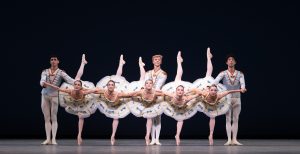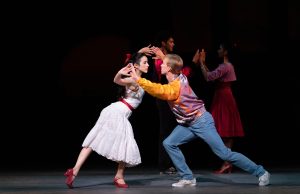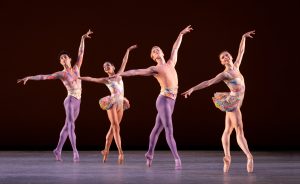
With the catchy title of Fresh & Fierce, Miami City Ballet opened its third program of the season at the Adrienne Arsht Center for the Performing Arts in Miami on April 14-16 (The program was also performed at the Kravis Center in West Palm Beach from April 21-23 and the Broward Center in Fort Lauderdale from April 29-30).
Adhering to the present artistic mission of the company, the Fresh & Fierce program presented a newly commissioned work by a young Miami-based choreographer, Durante Verzola, alongside the works of master choreographers George Balanchine and Jerome Robbins, who are regarded as two of the 20th century’s most iconic American ballet choreographers.
The evening’s music selection also stretched the gambit, commencing with a 18th-century Mozart divertimento to the familiar show tunes of West Side Story. The new work by Verzola was choreographed to a series of piano pieces by 20th-century composer Ernesto Lecuona, who is considered the Gershwin of Cuba.
First up on the Saturday night performance was Divertimento No. 15, now considered to be one of Balanchine’s best “tiara and tutu ballets,” which was set to Mozart’s glorious Divertimento No. 15 in B-flat (K. 287). Balanchine considered this particular divertimento by Mozart to be the finest ever written and had already choreographed a ballet called Caracole to this score when in 1956, he was invited to present a ballet at the Mozart Festival to be held at the American Shakespeare Theater in Stratford, Conn. Rather than reviving the original work, Balanchine decided to choreograph a new work using just a few movement phrases from Caracole.
The look of the ballet is crisp and clear. The costumes by Karinksa, with the pale blue, lemon yellow and baby pink confectionery colors in the men’s tunics and the women’s stiff white tutus, gave a whimsical, courtly air to the work. The pace of Mozart’s divertimento was rapid and relentless, but that was not an issue for the MCB dancers, who were all in fine form on April 15 and met the challenge with cool aplomb.
Using an unusual asymmetric structure for the soloists, Balanchine’s choreography paired five soloist females (Tricia Albertson, Ashley Knox, Samantha Hope Galler, Nathalia Arja and Taylor Naturkas) with just three men (Brooks Landegger, Francisco Schilereff and Damian Zamorano) along with a corps made up of eight women.
Six short and quick solo variations were danced in rapid fire one after the other. Arja was a standout with her usual clarity, easy speed and brilliant smile. Tall and handsome, Landegger, who joined MCB this season, was also a delightfully quick mover. Using deep and pliant pliés, he was able to finesse his fluid movement style with sharply accented stops and finishes.
Taylor Naturkas, who danced the sixth and last solo variation, was impossibly fast, skimming over the floor without hesitation like a perfectly poised hummingbird with its wings ablur.
The ensemble work by the corps de ballet in “Minuet” and the soloists in “Andante” had a freshness to it. The dancers were coached to move from the same source. Paired with rapid, clean footwork, a subtle buoyant energy emanated from their pelvises and rose up through their fluid torsos into their porte de bras and gaze.
In this ballet, it was so clear to see how Balanchine, who was also a highly accomplished musician, had honed his excellent craftmanship by choreographing intricate patterns of steps to catch every note, thus beautifully echoing the musical phrasing and coloring of Mozart’s score.

The other master on the program was Jerome Robbins, who as associate artistic director during the Balanchine era at New York City Ballet, choreographed more than 60 ballets. But Robbins is perhaps even better-known for his award-winning choreography for numerous Broadway musicals including the 1957 hit West Side Story, which he co-choreographed with Peter Gennaro to music by Leonard Bernstein and lyrics by Stephen Sondheim.
In 1994, Lincoln Kirstein, who was co-founder and general manager of NYCB, suggested that Robbins make a “choral ballet” of West Side Story for NYCB so that Kirstein “would not feel so desperately worried about our repertory and the aging of our audience.” Stringing together the best sections of the gang interaction between the Sharks and the Jets on the street and at the school dance in the gym, Robbin’s 34-minute version of the musical crackled with energy.
Chase Swatosh played Tony and Cameron Catanzaro made an excellent debut in the role of Riff, the leader of the Jets. Tricia Albertson gave a strong performance as Riff’s girlfriend, as did Ariel Rose in his debut role as Bernardo, the leader of the Sharks. All the dancers were totally vested in the performance, where they not only had to dance their hearts out but also had to belt out some songs. Some did this successfully and some did not succeed very well. The dancer who showed the most talent for singing was Catanzaro. Most of the songs were performed offstage by professional singers Natalie Avila and Marcela Galvis together with soloists Gerardo Ortega and Zoë Spangler.
Sandwiched between the two historic works by Balanchine and Robbins was the freshly commissioned ballet Sentimiento by former Miami City Ballet school student Verola. Having been exposed to the MCB repertory while he was training as a dancer, it is no surprise that the structure of the 27-year-old Verola’s ballet borrowed from one of Robbins’ greatest ballets, Dances at a Gathering (1969). Like Robbins, Verola also made use of the intimacy of short piano solos which were played live on stage as dancers entered and exited to dance in small groupings. However, that is where any similarity ended.

Lacking the same level of sophistication, Sentimiento was decidedly more mainstream with its popular and Latin-style music by Lecuona and the ballroom-inspired costumes by Miami fashion designer Esteban Cortázar.
Verola says that he was inspired by the dancers themselves as was Robbins in Dances at a Gathering, but this wasn’t evident in his rather unmemorable choreography. Out of the nine vignettes, the male duet danced by Alexander Kaden and Jordan Martinez and the female duet danced by Juliet Hay and Taylor Naturkas were the ones that stood out for the fresh energy and connection the dancers exuded.
Also part of the cast of Sentimiento was Francisco Rennó, MCB’s company pianist, who had arranged Lecuona’s music for the ballet. Sitting at the keyboard of a black grand piano (which was in the same location onstage as the piano in Dances at a Gathering), Rennó gave off an air of detachment with his downward, concentrated focus as he played for his fellow performers.
Cortázar’s costumes made a strong statement and at times, I found that they distracted from the dancing. There were lots of large ruffles, heavy ostrich feathers (either on a high-waisted tutu or on the hems of tunics), lots of velour leggings as well as an exceptionally wide-flared, black velour bell-bottomed unitard — all a little campy and none particularly flattering to the dancers. Perhaps all the various aspects of the ballet were intentional but the overall effect lacked cohesion.
What I found was fresh in the Fresh & Fierce program was seeing the Miami-based company performing at their home theater, and what I found was fierce was the appreciation the young, local audience has for the dancers in the company. I could really feel how much Miamians love their very own Miami City Ballet.